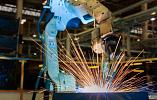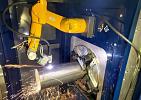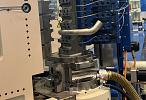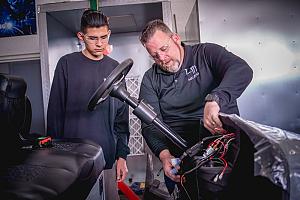President
- FMA
- The Fabricator
- FABTECH
- Canadian Metalworking
Categories
- Additive Manufacturing
- Aluminum Welding
- Arc Welding
- Assembly and Joining
- Automation and Robotics
- Bending and Forming
- Consumables
- Cutting and Weld Prep
- Electric Vehicles
- En Español
- Finishing
- Hydroforming
- Laser Cutting
- Laser Welding
- Machining
- Manufacturing Software
- Materials Handling
- Metals/Materials
- Oxyfuel Cutting
- Plasma Cutting
- Power Tools
- Punching and Other Holemaking
- Roll Forming
- Safety
- Sawing
- Shearing
- Shop Management
- Testing and Measuring
- Tube and Pipe Fabrication
- Tube and Pipe Production
- Waterjet Cutting
Industry Directory
Webcasts
Podcasts
FAB 40
Advertise
Subscribe
Account Login
Search
Making the move from hard automation to robotic welding
Water heater manufacturer successfully integrates laser vision seam tracking into its weld process
- By Jeffrey Noruk
- May 6, 2024
- Article
- Automation and Robotics

When a water heater manufacturer wanted to upgrade to robotic welding, it analyzed its entire production line to make full use of the latest automation. Thossapho l/ iStock / Getty Images Plus
Robotic arc welding has existed for more than 45 years, and the number of successful installations increases all the time. More than 20% of all robots going into factories now are for arc welding applications. One of the fastest growing segments within the robotic arc welding realm involves products that historically have been viewed as most suitable for hard automation: water heaters, gas tanks, wheels, compressors, and various storage tanks and pressure vessels.
The thought was that a welder only needed a dedicated torch because the weld seams on these types of parts are relatively simple and the product mix is small, so less flexibility is required. For example, when building water heater tanks, the primary variations are diameter and length, which can be handled with manual setup changes.
This article will explain how one company that manufacturers water heaters took the leap from hard automation welding to robotic arc welding systems integrated with laser vision seam trackers—a move that has increased productivity, improved quality, and added flexibility while opening up possible applications with many similar products.
Robots versus Hard Automation
There are four specific methods of applying arc welding to welded components: manual, semiautomatic, machine, and automatic welding. Within the automatic welding category, there is flexible automation (robotic) and hard automation (see Figure 1). Hard automation welding still typically requires an operator to observe the process (see Figure 2), while flexible welding is done with little or no human intervention. In a hard automation cell, the torch or part moves through only one path, so there is little flexibility for handling different part shapes, part sizes, or joint types. An operator typically observes the welding arc and adjusts the torch position to compensate for the changing joint position.
Automation that uses servo-controlled slides with a mechanical probe is the next step up on the automation ladder from hard automation. From there a shop can upgrade to laser vision seam tracking—technology that A.O. Smith has used for years to handle a variety of defined conditions within the work envelope of the servo slides.
Robotic welding, by definition, is the most flexible because it can be fully programmable and can weld any part within its working envelope.
Water Heater Welding Processes and Techniques
A.O. Smith has been in the water heater business since the early 1900s and has multiple plants in the U.S. and other countries.
The company’s Ashland City, Tenn., plant makes residential gas and electric water heaters in sizes from 30 to 80 gal. This facility brings in steel rolls on one end of the plant and through a series of operations—including cut to length, rolling, piercing, forming, welding, painting, and assembly—produces more than 1.5 million water heaters a year at a rate of one tank every 45 seconds. Made from ASTM A1008 material in diameters from 14 to 22.5 in., the plant’s tanks range from 20 to 60 in. long.
The company’s use of hard automation welding to produce the tanks has evolved from manual torch adjustment to tactile probe tracking to laser vision tracking. Most recently, the plant moved to full robotic welding. Four new robot welding cells (each with three welding robots and one handling robot) were installed to complete the bottom-to-shell and flue-to-head lap joint welds (see Figure 3).
The wire feed speed on those welds is typically 380 in./min. using 1/16-in. E70T-2 flux-cored wire. The DC electrode positive welding system uses 100% CO2 as an assist gas at 24.5-V power to weld 70 to 80 in./min.

FIGURE 1. For welding machines, automation can be divided into two categories—flexible and hard automation.
Figure 4 shows a circumferential bottom weld from the robotic welder, and Figure 5 shows typical weld cross sections of both the circumferential bottom weld and flue weld. Note in the cross section the deep, long fusion line that extends the leak path, thus reducing the number of rejected tanks.
Welding Criteria
The primary criteria for the finished welds are:
- Acceptable strength.
- Minimal oxidation and surface interruptions of the back side of the weld, which could cause issues with the adhesion of the protective coating.
- Freedom from defects (lack of fusion, lack of penetration or porosity) that could result in a leak.
While leaks associated with welds in service were not excessive with hard automation, historically about 10% of the tanks had some detectable leaks at the final leak test station. This means that the pressure testing stations located at the end of the lines flagged one in 10 tanks for repair or further review.
One defect that is even 1/64 in. long can cause a rejection, so there is very little margin for error. One of the main causes of leaks was improper weld wire position in the joint, an off-seam condition that laser vision seam trackers were able to minimize. Figure 6 shows the weld pool position with respect to the weld seam. The red + signifies where the laser vision seam tracks the joint and tells the robot where to place the weld wire.
Moving to Robotic Arc Welding
A study of the Ashland City plant analyzing the effects of installing robotic arc welding automation showed that ROI of two years or less was achievable. The total investment was not just for the robotic arc welding cell but also involved a series of upstream operations that needed to be changed and improved.
The more automated a system becomes, the more the parts coming into the station need to be the same. An operator can do things to compensate for different part fit-up and variation that an automated cell without an operator cannot accommodate. A business must start at the beginning of the process and build components that are consistent and within the process capability to be successful.
To accomplish this, A.O. Smith installed equipment at the beginning of the line that accurately cut to length the shell used to make the body of the tank. Then the company installed new mash seam resistance welding machines. This combination provided a round, consistent shell with virtually no detectable seam. It also eliminated the typical leaks at the weld intersection on the circumferential welds and the need to add manual welds to strengthen the end of the long seam welds.
The company also redesigned the head and bottom presses to provide good fit-up with virtually no weld joint gaps. Then changes were made in the application of the enamel (glassing) coating used to protect the inside of the tank. The glassing material was masked in the welding area, eliminating a contaminant that is responsible for most of the leaks associated with the welding of water heater tanks.
In addition to these upstream improvements, other changes were made to greatly improve the overall payback of this project.
First, Servo-Robot AUTO-TRAC seam tracking units were installed on the hard automation welding machines, replacing the older mechanical tracking technology and allowing A.O. Smith to fully automate these welding cells. A single technician now monitors four weld stations, decreasing the number of hours required for tracking.

FIGURE 2. An operator watches a hard automation system to ensure the process and torch position are stable.
Second, these hard automation cells are now loaded and unloaded using material handling robots, further reducing variation in cycle time and reducing labor hours.
The main sources of payback for the robotic arc welding systems include improved productivity, reduced repair and scrap, reduced leak testing, and greater flexibility to produce tanks in smaller lot sizes. This move to robotics also involved using a cellular manufacturing approach in which more operations are in parallel and involve both arc welding and material handling robots in the same cell.
Improvements: The Details
To understand the benefits of using flexible robotic welding systems with integrated seam tracking over traditional hard automation, with or without mechanical or laser vision tracking, you must look hard at the details. There are some key advantages.
Infinite Programmability. A robot is infinitely programmable, so it can handle any part that fits into its working envelope. In this application, the robot is handling different tank diameters and lengths (seam location), electrical as well as gas heaters, and both the bottom-to-shell seam and the flue-to-head seam. Impossible with a single-torch hard automation system, this flexibility results in less setup time and thus higher arc time.
Flexible Production. As mentioned previously, in each of the four identical cells, the material handling robot performs unload/load into the 7th axis positioned fixturing. Having identical cells with identical robot arc welding setups means that production can be ramped up and down in small increments of capacity, thus supporting a just-in-time philosophy. In addition, if a robot goes down for any reason, only 8% of total production is lost. Greater uptime and throughput are thus achieved from this type of cellular arrangement.
Shorter Setup Times. The shop gained several hours of production time daily by reducing setup time for the different tank models. This was accomplished in the robot cells by having different programs easily selected by the operator via the user screen.
Better Torch Position. To achieve optimum weld speed and quality, it is important to have the correct torch relationship to the joint, which includes work and torch angles as well as the torch location around the circumference with respect to top dead center. With the robot, these angles and positions can be optimized for each tank.
Easier Torch Cleaning. Torch cleaning has always been a customized solution with hard automation. With the robot, the torch cleaning can be done during unload/load, thus improving uptime and eliminating the need for time-intensive human intervention.
Tighter Control. Robotic arc welding with integrated seam tracking allows for optimum control, including the ability to adapt the welding process (travel speed, current) to compensate for gaps due to varying fit-up. This capability improves weld quality, thus reducing leaks.
Keys to Success
To ensure success, a project must have the right equipment applied at the right time by the right people. Several specific actions can help ensure the installation of flexible robotic arc welding with real-time laser vision seam tracking is successful:
- Champion from start to finish - The champion is someone who leads the team through the good times and bad. Every project will experience problems, and some people will want to give up and go back to the old ways. A champion helps marshal the team through those tough spots to the finish line.
- The right equipment vendor - Selecting a robot and seam tracking equipment from a strong company that’s able to support it and provide ongoing enhancements to support continuous improvement efforts is a must.
- Proper training - Training key people on the team in the areas of setup, programming, and maintenance (preventive and ongoing) will help ensure your success.
- Broad acceptance - A critical mass of people at your plant must accept the new technology—which reinforces the importance of having a dedicated champion.
Future Possible Improvements
Further fine tuning of the automated welding with respect to laser vision seam tracking will continue to optimize the process. Other advanced welding processes like laser and resistance welding are being evaluated for potential future use on new models.
Automation and adaptive controls, like the laser vision systems, are critical to the ultimate success of manufacturing here in the U.S., especially if domestic shops want to compete in today’s global economy.
About the Author
Jeffrey Noruk
P.O. Box 69
Mequon , WI 53092
262-238-4625
About the Publication
Related Companies
subscribe now

The Tube and Pipe Journal became the first magazine dedicated to serving the metal tube and pipe industry in 1990. Today, it remains the only North American publication devoted to this industry, and it has become the most trusted source of information for tube and pipe professionals.
start your free subscription- Stay connected from anywhere

Easily access valuable industry resources now with full access to the digital edition of The Fabricator.

Easily access valuable industry resources now with full access to the digital edition of The Welder.

Easily access valuable industry resources now with full access to the digital edition of The Tube and Pipe Journal.
- Podcasting
- Podcast:
- The Fabricator Podcast
- Published:
- 05/14/2024
- Running Time:
- 62:12
Cameron Adams of Laser Precision, a contract metal fabricator in the Chicago area, joins the podcast to talk...
- Trending Articles
Making the move from hard automation to robotic welding

Students learn fabrication one piece at a time

Miscellaneous metals fabricator increases productivity and opportunity with plasma cutting

Get a grip on the misunderstood tube bender motor starter

Manufacturing finally sees some sunshine

- Industry Events
Laser Welding Certificate Course
- May 7 - August 6, 2024
- Farmington Hills, IL
World-Class Roll Forming Workshop
- June 5 - 6, 2024
- Louisville, KY
Advanced Laser Application Workshop
- June 25 - 27, 2024
- Novi, MI
Precision Press Brake Certificate Course
- July 31 - August 1, 2024
- Elgin,




























